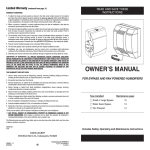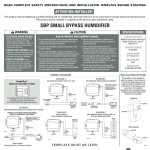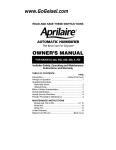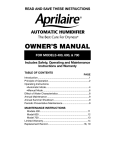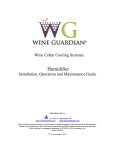Download Carrier OG-HUM-03 Owner`s manual
Transcript
READ AND SAVE THESE INSTRUCTIONS OWNER’S MANUAL FOR BYPASS AND FAN POWERED HUMIDIFIERS Includes Safety, Operating and Maintenance Instructions ©2005 CAC/BDP 7310 West Morris St., Indianapolis, IN 46231 10006720 11.05 B2203903A Form/Catalog: OG-HUM-03 Bypass and Fan Powered Humidifiers Table of Contents Page Introduction . . . . . . . . . . . . . . . . . . . . . . . . . . . . . . . . . . . . . . . . . . . . . . . . . . . . 2 Principle of Operation . . . . . . . . . . . . . . . . . . . . . . . . . . . . . . . . . . . . . . . . . . . . 2 Operating Instructions . . . . . . . . . . . . . . . . . . . . . . . . . . . . . . . . . . . . . . . . . . . 4 Effect of Water Characteristics . . . . . . . . . . . . . . . . . . . . . . . . . . . . . . . . . . . 8 Annual Maintenance. . . . . . . . . . . . . . . . . . . . . . . . . . . . . . . . . . . . . . . . . . . . . 8 Annual Summer Shutdown . . . . . . . . . . . . . . . . . . . . . . . . . . . . . . . . . . . . . . . 8 Periodic Preventative Maintenance . . . . . . . . . . . . . . . . . . . . . . . . . . . . . . . 9 Maintenance Instructions Small and Large Bypass Humidifiers . . . . . . . . . . . . . . . . . . . . . . . . . . . 10 Fan Powered Humidifiers . . . . . . . . . . . . . . . . . . . . . . . . . . . . . . . . . . . . . 11 WARNING! 120 VOLTS may cause injury from electrical shock. Disconnect power and shut off water supply before servicing. CAUTION! Sudden operation may cause personal injury or property damage. Turn humidistat to “OFF” before servicing. Introduction Thank you for your recent humidifier purchase. We sincerely appreciate your business and are pleased to add your name to our growing list of customers. Now, please take a few minutes and read this booklet. This will familiarize you with the benefits you will receive from the equipment you just purchased and help you understand the routine maintenance that will be required. I. Principle of Operation You have purchased a humidifier that operates on the evaporative principle. It will provide the proper relative humidity (see operating instructions) all during the heating season. It is very possible that you have questions concerning what your new humidifier can do for you, and what you should do to receive maximum benefits from it. This booklet is intended to answer these questions. 2 The humidifier operates in conjunction with the furnace blower motor. When the humidistat calls for humidity and the blower motor is operating, water flows to the distribution pan located at the top of the unit. The water is uniformly distributed across the width of the pan and through a scientifically designed system of outlets. It flows by gravity over the humidifier pad. Dry, hot air is moved through the moisture-laden humidifier pad where evaporation takes place. The now-humidified air carries moisture in vapor form throughout the home. The correct water flow is determined by an orifice in each unit. When the unit is operating, there will be a small, steady stream of water to drain, which flushes away most of the trouble-causing minerals. Do not use the saddle valve to regulate the water flow. It is designed to be completely opened or closed. The minerals and solid residue not trapped by the replaceable humidifier pad are flushed down the drain. The drain also eliminates the problems caused by stagnant water. This is the most effective and least expensive method to dispose of trouble-causing minerals. Trouble-free performance and minimum maintenance are assured by the design features of the humidifier. All unit housing parts that come in contact with water are non-metal and will never rust or corrode. Neither heat nor water will affect them under normal operating conditions. The humidifier pad, designed especially for uniform, high evaporation, and the Scale Control Insert also efficiently trap mineral deposits which are often the cause of damage to working parts in ordinary humidifiers. No “white dust” can be distributed throughout the living quarters. The humidifier pad must be in good condition to assure high capacity trouble-free performance. It should be changed annually. Older design water distribution trays have a granular coating in the bottom of the distribution tray to provide equal distribution of water to each of the openings assuring an even flow over the humidifier pad. Do not clean the mineral scale off the bottom of the water distribution tray at the end of the humidification season. If the granular coating is removed, it is not necessary to purchase a new distribution tray. You can accomplish the same uniform performance by applying a small amount of liquid dishwashing soap over the entire inside surface of the water distribution tray. This will allow the water to flow evenly through each of the openings, provided the unit is level, in order to achieve maximum capacity. The current distribution tray which incorporates a synthetic fabric liner that replaces the granular coating, is designed to deliver water uniformly over the entire top surface of the humidifier pad, provided it is mounted level. It is normal for some mineral deposits to form in the distribution tray as it dries out between humidification cycles. These deposits can actually help distribute water in the tray, but if they form enough to block the openings, they should be removed as described in the “Periodic Preventative Maintenance” section of this manual. 3 II. Operating Instructions Your new humidifier is controlled by a manual humidistat, HumidiTrac™ or Thermidistat™, installed either in the living area or in the cold air return. Automatic Humidifier Control: (Manual Humidifier Control – see page 6) Your HumidiTrac™ Control is installed in the cold air return. During the first heating season, your HumidiTrac™ Control needs to be set initially to match your home’s condition. Please follow these steps when adjusting your control (refer to Figure A). 1. Turn the dial setting knob to “5,” which is within the normal range. During the next 24-48 hours it may be necessary to adjust the dial for more or less humidity, depending on your personal comfort and home’s requirements. Refer to “TABLE 1 – Operation Guide”. 2. During the coldest portion of the first heating season, minor adjustments may be necessary. This is dependent upon your individual home construction, refer to “TABLE 1 – Operation Guide”. TABLE 1 – Operation Guide Condition Solution TABLE 2 – % Relative Humidity Guide Reduce the setting on the control dial by 1 increment. Lack of humidity Increase the setting on the control dial by 1 increment. Humidifier does not operate Turn dial to “Test.” Make certain furnace and blower are operating. If unit still doesn’t operate, consult your air conditioning and heating dealer. Humidifier won’t shut off Turn dial to “Off.” If unit continues to operate, consult your air conditioning and heating dealer. Test mode System operation is checked by setting the knob to “Test.” Make certain furnace and blower are operating. Humidifier will operate for one minute. Dial Setting Outdoor Temperature (°F) Condensation on windows The relative humidity in your home will now be accurately controlled to meet your needs and should not need further adjustment during future heating seasons. Make note of the dial setting in the event you temporarily move the knob when performing annual maintenance of the Humidifier. Your Automatic Humidifier, is a high precision system that will accurately maintain the relative humidity in your home. For every 1°F change in outdoor temperature, the control will automatically adjust the indoor relative humidity (RH) by 1/2%. If you would like to determine the RH in your home, follow these steps: 1. Determine the outdoor temperature. 2. Activate the furnace blower by setting your thermostat fan switch to the “On” position, or setting your thermostat to a higher temperature. 3. Turn the control dial setting to the “Off” position. Then, slowly turn the dial clockwise until you hear the solenoid valve “click on.” Next, slowly turn the dial counter-clockwise until you hear the solenoid valve “click off.” At this point, make note of the dial setting. 4. Locate your dial setting on Table 2. Follow the dial setting to the right until it intersects with the current outdoor temperature. This is the relative humidity in your home under existing conditions. 5. Return the thermostat and the Humidifier Control to their original settings. -10 0 10 20 30 40 1 10 10 10 15 20 25 2 10 10 15 20 25 30 3 10 15 20 25 30 35 4 15 20 25 30 35 40 5 20 25 30 35 40 45 6 25 30 35 40 45 45 7 30 35 40 45 45 45 As an example, if the outdoor temperature is 20°F, and, following step 3, the humidifier turns off at “5” on the dial range, then the RH in your home is 35%. FIGURE A The HumidiTrac™ Control will accurately control the humidity in your home to a maximum of 45% RH and a minimum of 10% RH. The values of outdoor temperature and dial settings may fall in between or outside of the listed values in Table 2. In these cases, you can only approximate your home’s actual indoor RH. 90-1054 4 5 To check the humidifier’s operation, note the current setting and set the HumidiTrac™ Control to the test mode when the furnace blower motor is operating. Water will flow into the humidifier for 1 minute and then it will turn off. This insures the unit is operating properly. Do not leave the control in the test mode as it will not operate. Reset the control to it’s original setting. Manual Humidistat or HumidiTrac™ in Manual Mode: (Automatic Humidifier Control – see page 4) Your new Humidifier is controlled by a humidifier control installed either in the living area (typically near the thermostat) or in the cold air return. It is important to anticipate a drop in outdoor temperature and reduce the setting accordingly to avoid excessive condensation. For example, with an outdoor temperature of 20°F the correct setting will be 35% relative humidity. If the temperature is expected to fall to 0°F that evening, then merely reduce the setting to 25% several hours prior to the temperature change. The recommended settings on the humidifier control are based on years of research (see Table 3) and experience as to what is best for the average home. These settings represent a compromise between RH levels that would be most desirable for comfort reasons and humidity levels that are suitable for protection of your home. For example, a wintertime indoor RH of 50% may be considered ideal by some, but unfortunately, it probably would result in damage to your home. Observance of the recommended RH levels on your humidistat, therefore, is an important safeguard. Condensation of water on inside windows in the form of fogging or frost is usually an indication of too high relative humidities. This same condensation can take place in other areas in your home with the possibility of damage resulting. To check the humidifier operation, set the humidifier control above the click point, make sure that the water saddle valve is open and that there is electricity to the unit. Generally, the furnace and blower motor must be operating for the humidifier control to function. After the humidifier has operated for several minutes and water is entering the unit and coming out at the drain, reduce the humidifier control setting below the click point and the unit should automatically shut off. Now set the humidistat dial at the recommended inside relative humidity, depending on the outside temperature. Follow the suggested settings prior to a drop in the outside temperature. Additional Information Be sure to keep fireplace dampers closed when not in use. They provide an excellent escape route for heat, as well as humidity. Humidity is lost at an even faster rate than heat because water vapor tends to seek its own level and your humidifier would not be able to replace it even when running at full capacity. On occasion, indoor moisture producing activities such as clothes drying, cooking, showers, etc., may raise the relative humidity level higher than it should be, even though the Humidifier is not operating. Telltale indications, again, are condensation or frost on cold surfaces such as windows, doors, walls, etc. If such condensation persists for several hours, your home should be ventilated to dissipate the potentially damaging excess moisture. TABLE 3 – Outdoor-Indoor Relative Humidity Outside Temperature Recommended RH +40°F +30°F +20°F +10°F 0°F –10°F –20°F 45% 40% 35% 30% 25% 20% 15% The Humidifier Control is a precision instrument that can be used to determine the RH accurately in your home during the winter. Turn the dial to the lower setting, then reverse the dial direction slowly until a “click” is heard. At this point, read the RH on the dial. This will be very close to the actual RH in your home. 6 7 III. Effect of Water Characteristics VI. Periodic Preventative Maintenance Your humidifier will operate effectively using either hard or mechanically softened water. Any type of water (hard, soft, hot, or cold) is acceptable for use with the drain-type humidifiers. Hot supply water, 140° maximum, is recommended for all heat pump applications. The use of hot supply water will also increase the amount of humidity generated in other applications. The heat in the water increases evaporation and the water going to the drain is cold to the touch. For better performance it is recommended that soft (reduced minerals) or filtered water be supplied to the humidifier pad. This can help reduce the amount of scale and mineral deposits that can accumulate on the pad. NOTE: Periodic inspection and preventative maintenance of your total heating system is important for efficient and safe operation. Your dealer will include humidifier service during a maintenance inspection. Your humidifier is equipped with an in-line water strainer and orifice as shown below. These parts should be inspected and cleaned periodically to assure continued proper unit performance. IV. Annual Maintenance For best performance, we recommend that you replace the humidifer pad in your humidifier annually. • Call the installer of your humidifier. This information is often found on your equipment. V. Annual Summer Shutdown FOR THE SUMMER HUMIDIFIER SHUTDOWN, SIMPLY TURN THE HUMIDISTAT CONTROL TO THE “OFF” SETTING AND CLOSE THE DAMPER IN THE BYPASS HUMIDIFIER. (TURN DAMPER HANDLE TO “SUMMER” POSITION) 8 Inspection and Service Instructions 1. Disconnect electrical power to the furnace and shut off water supply. 2. Disconnect the water line at the inlet fitting. 3. Remove the in-line strainer from inside the inlet fitting by ORIFICE using a small nail or wire. 4. Flush the in-line strainer to clean it. If it is necessary SOLENOID to replace the strainer, contact your dealer for a VALVE replacement. INLET 5. Disconnect the water line at the outlet fitting. 6. Inspect plastic feed tube by gently flexing it and looking IN-LINE for cracks or signs of wear. Replace tube if it is cracked, STRAINER brittle, or has been damaged. 7. Remove the orifice from the copper or plastic tube and INLET make sure this small opening is unplugged. COMPRESSION NUT 8. Replace the orifice and reconnect the outlet water line 90-1053 (Double Wrench To Prevent Leaking And Valve Damage). 9. Replace the inline strainer and reconnect the inlet water line (Double Wrench To Prevent Leaking And Valve Damage). 10. Inspect the drain hose to make sure it has a constant downward slope and is not flattened or blocked. Flex the hose to loosen any mineral deposits or blockage. Flush it with water under pressure to remove any debris. 11. Turn on water supply and reconnect electrical power to the furnace. OUTLET COMPRESSION NUT 9 MAINTENANCE INSTRUCTIONS FOR FAN POWERED HUMIDIFIER MAINTENANCE INSTRUCTIONS FOR SMALL AND LARGE BYPASS HUMIDIFIERS 3 4 5 2 7 1 1. Front Cover 2. Feed Tube 3. Nozzle 4. Evaporative Assembly 5. Distribution Tray 6. “V” Notches 7. Humidifier Pad 8. Scale Control Insert 9. Drain Hose 10. Bypass Damper 90-819 1. 2. 3. 4. 5. 6. 7. 8. 9. 6 Front Cover Base Evaporative Assembly Distribution Tray ”V” Notches Humidifier Pad Scale Control Insert Drain Hose Power Cord 8 CAUTION! Sudden operation may cause personal injury or property damage. Turn humidistat to “OFF” before servicing. 1. 2. 3. 4. Note humidistat setting and turn humidistat to the “OFF” position. At the side of the unit opposite the airflow duct, pull front cover (1) off holding with both hands and set aside. Carefully pull the feed tube (2) out of the nozzle (3) at the top of the evaporative assembly (4). Pull this assembly out by grasping at top and tipping out. Remove the black distribution tray (5) from the evaporative assembly by unsnapping the white plastic ends of the Scale Control Insert (8), from the tabs at the end of the tray. Follow the instructions below depending upon the type of distribution tray in your humidifier: For trays with a synthetic fabric liner: Lightly scrape out or brush off any mineral deposits, being careful not to stretch or loosen the synthetic fabric liner. Soaking the tray in vinegar or a lime-removing agent is helpful when trying to remove stubborn mineral deposits. For trays with granular coating: Do not scrape off the granular coating, but lightly scrape out any mineral deposits and clean the “V” notches (6). This textured surface helps ensure even water flow for maximum performance. If the granular coating has been removed, place several drops of liquid dishwashing soap on the distribution tray. This will only need to be done once if there is no granular coating. Slide the humidifier pad (7) out from the plastic Scale Control Insert (8). Clean the insert frame by twisting and flexing it to loosen the calcium deposits, or use a putty knife. Replace the humidifier pad (Part No. P110-1045 for Small Bypass Humidifier and Part No. P110-3545 for Large Bypass Humidifier) and slide the pad back into the scale control insert frame with color mark up. Snap the black distribution tray (5) back into place. 6. Inspect plastic feed tube by gently flexing it and looking for cracks or signs of wear. Replace tube if it is cracked, brittle, or has been damaged. 7. Reinstall the evaporative assembly into the unit by fitting its drain tube into the round receptacle at the base of the unit. Push the assembly in at the top against the beveled tabs that will hold it in place. Push the end of the feed tube back firmly into the nozzle and replace the front cover. 8. Remove the drain hose (9) from the bottom of the unit and bend and flex it to loosen the internal calcium deposits. Then flush it with water under pressure and slip it back onto the black drain fitting. Make sure the drain hose has a constant downward slope and is not flattened or blocked. 9. Check system operation: Manual Humidistat: With the furnace blower operating and the furnace calling for heat, turn up Humidistat and check system operation. HumidiTrac™ Humidifier Control: (Automatic or Manual) Check system operation and reset Change Humidifier Pad indicator by setting the knob to “Test/Reset”. With furnace blower operating and furnace calling for heat, humidifier will operate for one minute. DO NOT LEAVE IN TEST MODE AS HUMIDIFIER WILL NOT OPERATE. 10. Set Manual Humidistat or HumidiTrac™ Humidifier Control to its original position. 90-858 5. 10 9 WARNING! 120 VOLTS may cause serious injury from electrical shock. Disconnect power and shut off water supply before servicing. 1. Note humidistat setting and turn humidistat to the “OFF” position. 2. Disconnect electrical power and turn off water supply. 3. Unlatch humidifier cover assembly (1) from base assembly (2) at the bottom of the cover, lift, and set aside. 4. Pull out the evaporative assembly (3) by grasping at the top and tipping out. 5. Remove the black distribution tray (4) from the evaporative assembly by unsnapping the white plastic ends of the Scale Control Insert (7), from the tabs at the end of the tray. Follow the instructions below depending upon the type of distribution tray in your humidifier: For trays with a synthetic fabric liner: Lightly scrape out or brush off any mineral deposits, being careful not to stretch or loosen the synthetic fabric liner. Soaking the tray in vinegar or a lime-removing agent is helpful when trying to remove stubborn mineral deposits. For trays with granular coating: Do not scrape off the granular coating, but lightly scrape out any mineral deposits and clean the “V” notches (5). This textured surface helps ensure even water flow for maximum performance. If the granular coating has been removed, place several drops of liquid dishwashing soap on the distribution tray. This will only need to be done once if there is no granular coating. 6. Slide the humidifier pad (6) out from the plastic Scale Control Insert (7). Clean the insert frame by twisting and flexing it to loosen the calcium deposits or use a putty knife. Replace the humidifier pad (Part No. P110-3545) back into the Scale Control Insert with the colored spot up and snap the black distribution tray (4) back into place. 7. Reinstall the evaporative assembly (3) into the base assembly (2). Push the evaporative assembly (3) in at the top between the retaining ribs that hold the assembly in place in a vertical position. 8. Remove the drain hose (8) from the bottom of the unit. Bend and flex it to loosen the internal calcium deposits. Then flush it with water under pressure and slip it back onto the drain fitting. Make sure the drain hose has a constant downward slope and is not flattened or blocked. 9. Reinstall cover assembly (1) by hooking at the top of base assembly (2) and latching at the bottom. 10. Reconnect electrical power (9) and turn on water supply. 11. Check system operation: Manual Humidistat: With the furnace blower operating and the furnace calling for heat, turn up Humidistat and check system operation. HumidiTrac™ Humidifier Control: (Automatic or Manual) Check system operation and reset Change Humidifier Pad indicator by setting the knob to “Test/Reset”. With furnace blower operating and furnace calling for heat, humidifier will operate for one minute. DO NOT LEAVE IN TEST MODE AS HUMIDIFIER WILL NOT OPERATE. 12. Set Manual Humidistat or HumidiTrac™ Humidifier Control to its original position. 11






